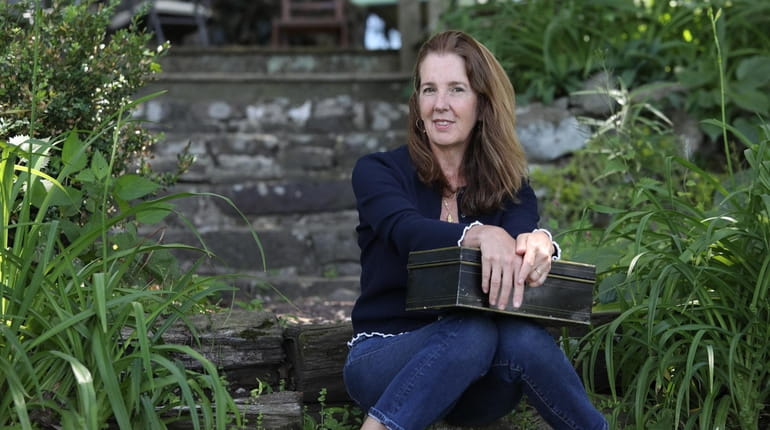Hofstra prof Martha McPhee talks about her novel 'An Elegant Woman'

Martha McPhee, outside her childhood home in Ringoes, New Jersey, holds a box of her grandmother's letters and postcards which figure in her novel " An Elegant Woman." Credit: Linda Rosier
Martha McPhee's grandmother knew how to spin a good family yarn. As a child, McPhee was told by her grandma that a family heirloom — a stunning china bowl — was previously owned by relatives of author James Fenimore Cooper (it wasn't). The matriarch also said that the family had ties to the Buster Brown shoe company (also untrue).
Still, those myths live on in McPhee's sixth novel "An Elegant Woman" (Scribner, 416 pp., $27), the story of a woman who leaves the wilds of Montana in the early 20th century and continually reinvents herself as she moves to various cities while advancing socially and professionally. Any resemblance between the main character and McPhee's grandmother is not the least bit coincidental.
McPhee, who has taught writing at Hofstra University in Hempstead since 2002, recently spoke to Newsday via Zoom from the family farm in Ringoes, New Jersey, that is one of the settings of "An Elegant Woman."
How long did it take you to put the book together?
My entire life. [Laughs.] Basically I wanted to write this novel since I knew I could be and wanted to be a writer. I’m a journal keeper and had early journals from my career as a writer. So when I was in my mid-20s, I was already trying to write this novel. But I didn’t know how to access it. …. Other books took over because I still wasn’t sure how to cover all of those things — the scope of the family, the scope of time. … I published my last novel in 2010, “Dear Money,” and I started this maybe two years later. It was about eight years of active writing and I put it down from time to time when I got really frustrated.
You have a wonderful description of the grandmother at the beginning of the book, where she's exquisitely dressed and really lives up to the title “An Elegant Woman.” Was your grandmother like that?
Oh definitely. … My grandmother, she was such a storyteller that she in a way was turning herself into a legend, into a myth. I saw that happening as I was writing. Part of her persona was this girl who from her humble beginnings claws her way out of a bad circumstance and becomes a refined woman in her eyes.
There are so many stories and legends you mention in the book, like your grandfather being the model for the Buster Brown logo and the bowl that supposedly belonged to James Fenimore Cooper’s family. Did you discover other myths about your own family as you were writing?
Definitely. Those were myths that my grandmother told us, but there was always a nugget of hard fact. … The quest wasn’t trying to sort out what was fact or fiction. It was more about the inheritance of the legacy of these stories and trying to pass down a sense of who we are and where we come from, even if it is fabricated. It took me a long time to understand that first she was turning herself into a myth in these stories and that she understood the power of storytelling. She understood that there is a beauty in being connected over time. I’ve got the baton right now and I’ll pass it on to my daughter and she’ll pass it on to hers.
What would your grandmother think if she was around to see the novel?
I know exactly what she’d say: I’ve died and gone to heaven. She would be so thrilled, and if there was a moment in the book she didn’t like, she’d say, “Imagination Jersey City Hall.” It wouldn’t faze her.
What's the first thing tell your students about being a writer?
That writing is hard. It takes discipline and you have to be willing to fail, to be rejected. You’re constantly rejected. You have to do it every day and you have to be willing to make sacrifices, and if there's anything else you see yourself doing, do that instead. I've been there long enough where I now have students who are publishing. It's so exhilarating.
Did you deal with rejection with your first novel?
No. [Laughs.] I was very fortunate. But I did with this novel. I went out too early with it. It was a different novel. It had a more experimental aspect to it. I showed it to my husband, my mom. A lot of people really loved it, but I understand what the problem was. It was both too ambitious and too experimental at the same time. The rejection took it somewhere extremely positive. The revision process with the help of my editor made it a much better book. …. That is what the life of a writer is.
